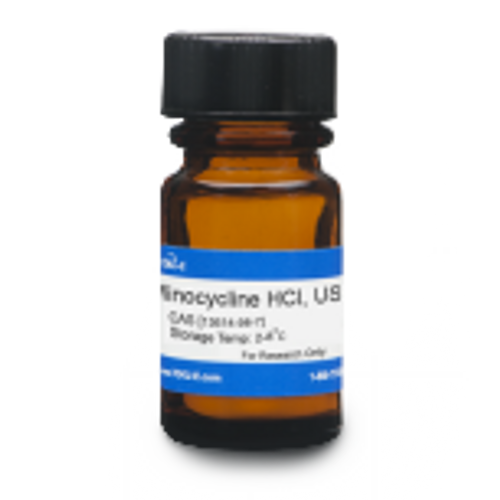Minocycline Hydrochloride is the hydrochloride salt of Minocycline, a broad-spectrum tetracycline patented in 1961 by Pfizer which came into commercial use in 1971. It inhibits bacterial protein synthesis. The compound has been found to inhibit PARP1 and nitric oxide synthase. It is an NMDA receptor antagonist and has neuroprotective effects. It also has chondroprotective effects in inflammatory models of arthritis. It also has anti-cancer properties.
Minocycline Hydrochloride is freely soluble in in water and slightly soluble in alcohol.
We also offer:
- Minocycline (M062)
| Mechanism of Action | Tetracyclines inhibit bacterial protein synthesis by entering the cell and binding to the 30s ribosomal subunit preventing binding of tRNA. Minocycline acts as a PARP1 inhibitor. It can also indirectly inhibit inducible nitric oxide synthase. |
| Spectrum | Minocycline Hydrochoride has a broad-spectrum of activity against Gram-negative and Gram-positive bacteria which cause infections of the upper respiratory tract. It can be used for methicillin-resistant Staphylococcus aureus (MRSA). |
| Microbiology Applications | Minocycline Hydrochloride is commonly used in clinical in vitro microbiological antimicrobial susceptibility tests (panels, discs, and MIC strips) against Gram-positive and Gram-negative microbial isolates. Medical microbiologists use AST results to recommend antibiotic treatment options. Representative MIC values include:
Several in vitro studies have shown Minocycline can inhibit HIV activation, proliferation and viral replication in microglia, macrophages and lymphocytes. |
| Eukaryotic Cell Culture Applications | Minocycline is an NMDA receptor antagonist and has neuroprotective effects. In models of neurodegenerative disease, it has shown promise in disease models of Huntington’s disease and Parkinson’s disease.
Minocycline has “chondroprotective” effects in inflammatory arthritis animal models. Nitric oxide (NO) is released from cartilage affected by osteoarthritis (OA) and thus the overproduction of NO has been implicated in the pathogenesis of arthritis. The effect of Minocycline on the expression of human OA-affected nitric oxide synthase (OA-NOS) and rodent inducible NOS (iNOS). Minocycline inhibited lipopolysaccharide- and interferon-γ-stimulated iNOS in RAW 264.7 cells in vitro. It did not influence the specific activity of iNOS in cell-free extracts. Minocycline should be evaluated as a potential therapeutic modulator of nitric oxide (Amin et al, 1996). |
| Cancer Applications |
Minocycline has anti-cancer effects on various cancer types including ovarian, breast, glioma, colorectal, liver, pancreatic, lung, prostate, melanoma, head and neck, leukemia (Rezaei et al, 2024). Experimental data confirm that the anti-proliferative, anti-angiogenic and matrix-stimulatory activities displayed by Minocycline increase its anti-metastatic and anti-tumor potential. |
| Molecular Formula | C23H27N3O7 ·HCl |
| Solubility | Freely soluble in water. Slightly soluble in alcohol. |
| Impurity Profile | Residue on ignition: ≤0.15% Heavy Metals: ≤10ppm Epi-Minocycline: ≤1.2% Others: ≤1.2% Total Related Substances: ≤2.0% |
| References |
Amin AR et al (1996) A novel mechanism of action of tetracyclines: Effects on nitric oxide synthases. Proc. Natl. Acad. Sci. USA 93(24):14014-14019 PMID 8943052 Chopra I and Marilyn Roberts M (2001) Tetracycline antibiotics: Mode of action, applications, molecular biology, and epidemiology of bacterial resistance. Microbiol. and Molec. Biol. Rev. 65(2): 232-260 PMID 11381101 Garrido-Mesa N, Zarzuelo A and Gálvez J (2013) Minocycline: Far beyond an antibiotic. Br. J. Pharmacol. 169: 337-352 Rezaei A, Moqadami A and Khalaj-Kondori M (2024). Minocycline as a prospective therapeutic agent for cancer and non-cancer diseases: a scoping review. Naunyn-Schmiedeberg's Arch Pharmacol 397:2835–2848 PMID 37991540 |
| MIC | Bacillus spp.| ≤0.06 - 2|| Bacteroides fragilis| ≤0.25 - >32|| Borrelia burgdorferi S.L.| 0.03 - 1|| Burkholderia cepacia| 0.5 - 64|| Chlamydia pneumonia| 0.015 - 0.031|| Chlamydia psittaci| ≥0.015|| Citrobacter freundii| 0.5 - >8|| Citrobacter koseri| 0.5 - 2|| Clostridium difficile| ≤0.25|| Clostridium perfringens (GAI 5526)| 0.063|| Corynebacterium jeikeium| ≤0.06 - 4|| Diplococcus pneumoniae| 0.01 - 0.4|| Edwardsiella hoshinae | 0.25 - 2|| Edwardsiella ictaluri | 0.06 - 0.5|| Edwardsiella tarda| 0.25 - 8|| Enterobacter aerogenes| ≤0.5 - ≥32|| Enterobacter agglomerans| >4 - >16|| Enterobacter amnigenus| 0.5 - >8|| Enterobacter cloacae| ≤0.5 - ≥32|| Enterobacteriaceae| ≤0.5 - 128|| Enterococcus avium| ≤0.06 - 16|| Enterococcus casseliflavus| 0.06 - >8|| Enterococcus durans| ≤0.06 - >8|| Enterococcus faecalis| ≤0.06 - 32|| Enterococcus faecium| ≤0.06 - 32|| Enterococcus gallinarum| 0.06 - 32|| Enterococcus hirae| ≤0.06 - >8|| Enterococcus raffinosus| 0.06 - 32|| Escherichia coli| 0.25 - ≥32|| Finegoldia magna (GAI 5528)| ≥0.125|| Fusobacterium| ≤0.015 - 4|| Haemophilus influenzae| 0.12 - 4|| Hafnia alvei| ≤0.06 - 4|| Helicobacter pylori| 0.05 - 0.78|| JK diphtheroids| 0.12 - 4|| Klebsiella pneumonia| ≤0.5 - >128|| Lactobacillus spp.| 0.03 - 2|| Leuconostoc spp.| 0.25 - <1000|| Listeria monocytogenes| 0.12 - 0.25|| Listeria spp. (Etest)| 0.03 - 8|| Moraxella catarrhalis| ≤0.06 - 0.25|| Morganella morganii| 2 - >8|| Mycobacterium abscessus| 0.25 - >64|| Mycobacterium avium complex| 8 - >64|| Mycobacterium chelonae| ≤0.12 - >64|| Mycobacterium fortuitum| ≤0.12 - >64|| Mycobacterium kansasii| 2 - 8|| Mycobacterium lentiflavum| 16 - >64|| Mycobacterium marinum| 0.125 - 8|| Mycobacterium peregrinum| ≤0.125 - 16|| Mycoplasma hominis| <4 || Mycoplasma pneumonia| 0.062 - 0.25|| Neisseria gonorrhoeae| 0.06 - 2|| Neisseria meningitidis| ≤0.06 - 0.12|| Neisseria spp.| 0.12 - >8|| Nocardia asteroides| 1.6 - 6.3|| Pantoea agglomerans| 0.25 - 4|| Pasteurella multocida| <1|| Pediococcus spp.| 0.5 - 2|| Peptostreptococcus| ≤0.015 - 4|| Peptostreptococcus anaerobius| ≥0.032|| Peptostreptococcus asaccharolyticus| ≥16|| Pneumococci| <0.06 - 16|| Porphyromonas| ≤0.015 - 8|| Prevotella intermedia| ≥0.02|| Propionibacterium granulosum| ≥0.25|| Proteus mirabilis| ≥8|| Proteus vulgaris| 4 - >8|| Providencia rettgeri| 4 - 8|| Providencia stuartii| 8 - >8|| Pseudomonas aeruginosa| ≤0.5 - >32|| Pseudomonas pseudomallei| 1.6 - 6.3|| Pseudomonas spp.| 0.25 - 8|| Salmonella spp.| 1 - >8|| Serratia liquefaciens| 0.5 - >8|| Serratia marcescens| ≤0.5 - ≥32|| Serratia odorifera| 0.5 - >8|| Shigella sonnei| 0.5 - >8|| Staphylococci| ≤0.06 - 2|| Staphylococcus aureus| 0.06 - 16|| Staphylococcus epidermidis| ≤0.015 - 8|| Staphylococcus haemolyticus| ≤0.06 - 8|| Staphylococcus hominis| 4 - >32|| Staphylococcus saccharolyticus| ≥0.125|| Staphylococcus spp.| 0.03 - 0.5|| Stenotrophomonas maltophilia| ≤0.06 - 2.5|| Streptococci | ≤0.015 - 64|| Streptococcus agalactiae| 0.06 - ≥16|| Streptococcus bovis| ≤0.06 - >8|| Streptococcus intermedius| ≥0.25|| Streptococcus pneumonia| 0.032 - 16|| Streptococcus pyogenes| <0.06 - 16|| Streptococcus spp.| ≤0.06 - >8|| Yersinia enterocolitica| 0.25 - 1|| |








